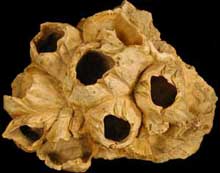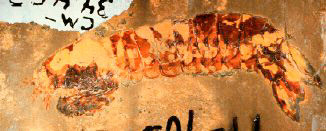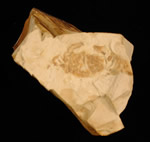 |
 |
 |
| Fossil remains of a barnacle (Cirripedia - left) and a crab (Decapoda - right) found in the UCMP teaching collection (Images by Karen Osborn). Fossil stomatopod, center (image by Dr. Cees Hof, used with permission). | ||
The crustaceamorpha have left relatively few fossils, but several sites around the world have provided lots of clues to the group's history. The Burgess Shale in British Columbia, Canada holds many of the earliest known phyllocarids such as Canadaspis from the middle Cambrian and Hymenocaris from the late Cambrian. Upper Cambrian rocks of Southern Sweden have provided many well preserved crustacean fossils, the majority of which are small swimming species. The most commonly found specimens in the Swedish sites are early ostracods, such as Vestrogothia and Hesslandona, but there are also many naupliar and later growth stages of unidentified crustaceans, the maxillopodans Bredocaris and Skara, and the branchiopodan Rehbachiella. The Chengjiang Formation in Southern China holds primarily bradoriids, which are similar to ostracods but are more closely related to barnacles.
On the whole the maxillopodan groups Ostracoda and Cirripedia and the Malacostraca have left the most significant fossil records. All crustaceans first appear in the fossil record in the Paleozoic Era. The following table summarizes when several major crustacean groups first appeared in the fossil record.
| Paleozoic Period | Age (millions of years ago) | Crustacean Group Appearance |
| Permian | 286 to 245 | |
| Carboniferous | 360 to 286 | |
| Devonian | 410 to 360 | Eumalacostraca |
| Silurian | 440 to 410 | Branchiopoda, Cirripedia |
| Ordovician | 505 to 440 | Ostracoda |
| Cambrian | 544 to 505 mya | Bradoriida (Cirripedia relatives), Phyllocarida |
